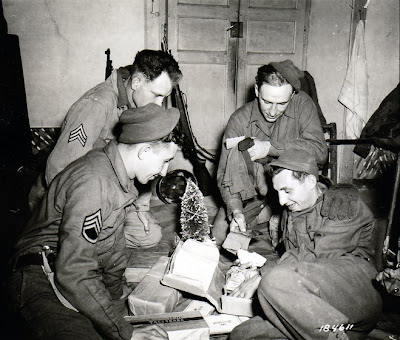 A rowdy group of American servicemen — note Santa Claus in center — are celebrating Christmas on Guadalcanal in the Solomon Islands, December 25, 1942. Note the sign posted on tree that reads “MERRY CHRISTMAS GUADALCANAL & TO HELL WITH TOJO.”
A rowdy group of American servicemen — note Santa Claus in center — are celebrating Christmas on Guadalcanal in the Solomon Islands, December 25, 1942. Note the sign posted on tree that reads “MERRY CHRISTMAS GUADALCANAL & TO HELL WITH TOJO.”
Tuesday, December 30, 2008
Christmas on Guadalcanal
 A rowdy group of American servicemen — note Santa Claus in center — are celebrating Christmas on Guadalcanal in the Solomon Islands, December 25, 1942. Note the sign posted on tree that reads “MERRY CHRISTMAS GUADALCANAL & TO HELL WITH TOJO.”
A rowdy group of American servicemen — note Santa Claus in center — are celebrating Christmas on Guadalcanal in the Solomon Islands, December 25, 1942. Note the sign posted on tree that reads “MERRY CHRISTMAS GUADALCANAL & TO HELL WITH TOJO.”
Labels:
1942,
Guadalcanal,
Pacific War,
Solomon Islands,
U.S. Army
Monday, December 29, 2008
Battle-Stained Guadalcanal Soldier
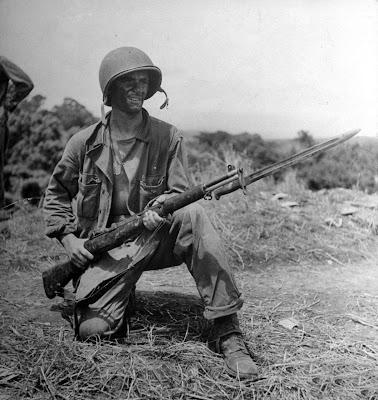 An American infantryman posing with his weapon is seen after a bloody battle for a 1,500-ft. peak euphemistically called the “Grassy Knoll” on Guadalcanal, in the Solomon Islands — 1943.
An American infantryman posing with his weapon is seen after a bloody battle for a 1,500-ft. peak euphemistically called the “Grassy Knoll” on Guadalcanal, in the Solomon Islands — 1943.
Labels:
1943,
Guadalcanal,
Pacific War,
Solomon Islands,
U.S. Army
Saturday, December 27, 2008
Evacuating the Wounded from Guam
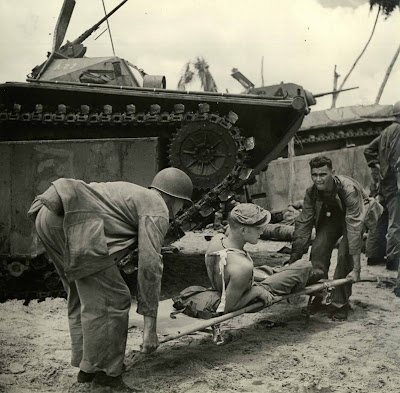 A wounded U.S. Marine is evacuated from the front lines during the Battle of Guam — July 21-August 8, 1944.
A wounded U.S. Marine is evacuated from the front lines during the Battle of Guam — July 21-August 8, 1944.
Labels:
1944,
Guam,
Marianas Islands,
Pacific War,
U.S. Marines
Thursday, December 25, 2008
Santa Claus — Army Style, 1941
 The panzer “Santa,” with well-filled sack of radios, books, cookies, and other gifts dear to soldiers’ hearts, glides up to the door of the barracks in Camp Lee's Quartermaster Corps, and it isn't hampered by lack of snow in Virginia. Camp Lee, Virginia, Quartermaster Replacement Center — December 1941.
The panzer “Santa,” with well-filled sack of radios, books, cookies, and other gifts dear to soldiers’ hearts, glides up to the door of the barracks in Camp Lee's Quartermaster Corps, and it isn't hampered by lack of snow in Virginia. Camp Lee, Virginia, Quartermaster Replacement Center — December 1941.
Labels:
1941,
Homefront,
Miscellaneous,
U.S. Army,
United States
Wednesday, December 24, 2008
Christmas in Wartime
Tuesday, December 23, 2008
Sharing Christmas Turkey
Monday, December 22, 2008
Christmas in the Hospital — 1942
 According to a U.S. Army publication, “one of the most successful Christmas decorations set up was the ward of this base hospital in Iceland. Together with the help of nurses, patients who were not tied down to their beds designed and put up the trimmings. Note the home made Christmas tree. Iceland, December 25, 1942.”
According to a U.S. Army publication, “one of the most successful Christmas decorations set up was the ward of this base hospital in Iceland. Together with the help of nurses, patients who were not tied down to their beds designed and put up the trimmings. Note the home made Christmas tree. Iceland, December 25, 1942.”
Saturday, December 20, 2008
Christmas Card for Adolf
 Private First Class Lyle School and Private First Class Lawrence W. Miller made this “bullet” Christmas card for "Dear Adolph" — Tidworth, England, U.S. Army, 175th Infantry, December 5, 1942. Never mind that they spelled the German dictator’s name wrong.
Private First Class Lyle School and Private First Class Lawrence W. Miller made this “bullet” Christmas card for "Dear Adolph" — Tidworth, England, U.S. Army, 175th Infantry, December 5, 1942. Never mind that they spelled the German dictator’s name wrong.
Labels:
1942,
Adolf Hitler,
Britain,
European War,
U.S. Army
Friday, December 19, 2008
Christmas Carols — Stateside
Thursday, December 18, 2008
Christmas — Army Style, 1941
Wednesday, December 17, 2008
Christmas Time in Italy — 1943
Tuesday, December 16, 2008
Battle of the Bulge Anniversary
Today marks the 64th anniversary of the beginning of what has come to be known as “The Battle of the Bulge.” Early on the misty winter morning of 16 December 1944, over 200,000 German troops and nearly 1,000 tanks launched Adolf Hitler's last bid to reverse the ebb in his fortunes that had begun when Allied troops landed in France on D-Day. Seeking to drive to the English Channel coast and split the Allied armies as they had done in May 1940, the Germans struck in the Ardennes Forest, a seventy-five-mile stretch of the front characterized by dense woods and few roads, held by four inexperienced and battle-worn American divisions stationed there for rest and seasoning.
After a day of hard fighting, the Germans broke through the American front, surrounding most of an infantry division, seizing key crossroads, and advancing their spearheads toward the Meuse River, creating the projection that gave the battle its name.
Stories spread of the massacre of soldiers and civilians at Malmedy and Stavelot, of paratroopers dropping behind the lines, and of English-speaking German soldiers, disguised as Americans, capturing critical bridges, cutting communications lines, and spreading rumors. For those who had lived through 1940, the picture was all too familiar. Belgian townspeople put away their Allied flags and brought out their swastikas. Police in Paris enforced an all-night curfew. British veterans waited nervously to see how the Americans would react to a full-scale German offensive, and British generals quietly acted to safeguard the Meuse crossings. Even American civilians who had thought final victory was near were sobered by the Nazi onslaught.
But this was not 1940. The supreme Allied commander, General Dwight D. Eisenhower rushed reinforcements to hold the shoulders of the German penetration. Within days, Lt. Gen. George S. Patton, Jr. had turned his Third U.S. Army to the north and was counterattacking against the German flank. But the story of the battle of the Bulge is above all the story of American soldiers. Often isolated and unaware of the overall picture, they did their part to slow the Nazi advance, whether by delaying armored spearheads with obstinate defenses of vital crossroads, moving or burning critical gasoline stocks to keep them from the fuel-hungry German tanks, or coming up with questions on arcane Americana to stump possible Nazi infiltrators.
At the critical road junctions of St. Vith and Bastogne, American tankers and paratroopers fought off repeated attacks, and when the acting commander of the 101st Airborne Division in Bastogne was summoned by his German adversary to surrender, he simply responded, "Nuts!"
Within days, Patton's Third Army had relieved Bastogne, and to the north, the 2d U.S. Armored Division stopped enemy tanks short of the Meuse on Christmas Day. Through January, American troops, often wading through deep snow drifts, attacked the sides of the shrinking bulge until they had restored the front and set the stage for the final drive to victory.
Never again would Hitler be able to launch an offensive in the West on such a scale. An admiring British Prime Minister Sir Winston Churchill stated, "This is undoubtedly the greatest American battle of the war and will, I believe, be regarded as an ever-famous American victory." Indeed, in terms of participation and losses, the battle of the Bulge is arguably the greatest battle in American military history.
Courtesy The United States Army Center of Military History
After a day of hard fighting, the Germans broke through the American front, surrounding most of an infantry division, seizing key crossroads, and advancing their spearheads toward the Meuse River, creating the projection that gave the battle its name.
Stories spread of the massacre of soldiers and civilians at Malmedy and Stavelot, of paratroopers dropping behind the lines, and of English-speaking German soldiers, disguised as Americans, capturing critical bridges, cutting communications lines, and spreading rumors. For those who had lived through 1940, the picture was all too familiar. Belgian townspeople put away their Allied flags and brought out their swastikas. Police in Paris enforced an all-night curfew. British veterans waited nervously to see how the Americans would react to a full-scale German offensive, and British generals quietly acted to safeguard the Meuse crossings. Even American civilians who had thought final victory was near were sobered by the Nazi onslaught.
But this was not 1940. The supreme Allied commander, General Dwight D. Eisenhower rushed reinforcements to hold the shoulders of the German penetration. Within days, Lt. Gen. George S. Patton, Jr. had turned his Third U.S. Army to the north and was counterattacking against the German flank. But the story of the battle of the Bulge is above all the story of American soldiers. Often isolated and unaware of the overall picture, they did their part to slow the Nazi advance, whether by delaying armored spearheads with obstinate defenses of vital crossroads, moving or burning critical gasoline stocks to keep them from the fuel-hungry German tanks, or coming up with questions on arcane Americana to stump possible Nazi infiltrators.
At the critical road junctions of St. Vith and Bastogne, American tankers and paratroopers fought off repeated attacks, and when the acting commander of the 101st Airborne Division in Bastogne was summoned by his German adversary to surrender, he simply responded, "Nuts!"
Within days, Patton's Third Army had relieved Bastogne, and to the north, the 2d U.S. Armored Division stopped enemy tanks short of the Meuse on Christmas Day. Through January, American troops, often wading through deep snow drifts, attacked the sides of the shrinking bulge until they had restored the front and set the stage for the final drive to victory.
Never again would Hitler be able to launch an offensive in the West on such a scale. An admiring British Prime Minister Sir Winston Churchill stated, "This is undoubtedly the greatest American battle of the war and will, I believe, be regarded as an ever-famous American victory." Indeed, in terms of participation and losses, the battle of the Bulge is arguably the greatest battle in American military history.
Courtesy The United States Army Center of Military History
Monday, December 15, 2008
A Dark Day at Pearl
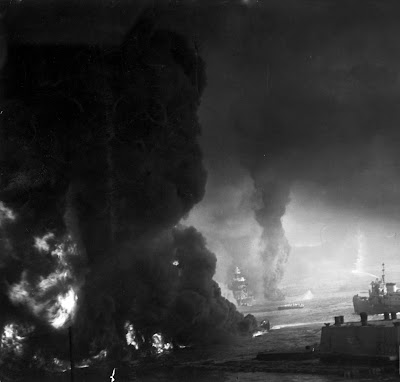 Dense black smoke from the wreckage of U.S. warships damaged or sunk that morning is seen filling the sky in an ominous way following the Japanese surprise attack on Pearl Harbor on December 7, 1941.
Dense black smoke from the wreckage of U.S. warships damaged or sunk that morning is seen filling the sky in an ominous way following the Japanese surprise attack on Pearl Harbor on December 7, 1941.
Labels:
1941,
Japan,
Pacific War,
Pearl Harbor,
U.S. Navy,
United States
Sunday, December 14, 2008
“Friendly Fire” in Hawaii

One of the aspects of the Japanese attack on Pearl Harbor in December 1941 that is rarely publicized or discussed are the incidents of “friendly fire” (casualties caused by American forces) to the civilian population on the island of Oahu. Because no attack was obviously expected, much of the ammunition and artillery was not prepared for battle. While returning fire against the attacking Japanese planes, the anti-aircraft shells were not set for the proper detonation, and as a result didn’t explode until the shells came down in the midst of the residential and business districts outside of the naval and air bases.
Labels:
1941,
Japan,
Pacific War,
Pearl Harbor,
U.S. Army,
U.S. Navy,
United States
Thursday, December 11, 2008
Not Only Ships Were Destroyed
 The wreckage of a U.S. Coast Guard Boeing B-17 bomber is seen after it was destroyed by flares set off by Japanese bullets. The flares burned the plane in half as pilot Ray Swenson made a crash landing at Hickam Field at Pearl Harbor on December 7, 1941. It was the only Coast Guard plane destroyed during Japan's surprise attack.
The wreckage of a U.S. Coast Guard Boeing B-17 bomber is seen after it was destroyed by flares set off by Japanese bullets. The flares burned the plane in half as pilot Ray Swenson made a crash landing at Hickam Field at Pearl Harbor on December 7, 1941. It was the only Coast Guard plane destroyed during Japan's surprise attack.
Labels:
1941,
Aircraft,
Japan,
Pacific War,
Pearl Harbor,
United States
Wednesday, December 10, 2008
Capsized U.S.S. Oklahoma
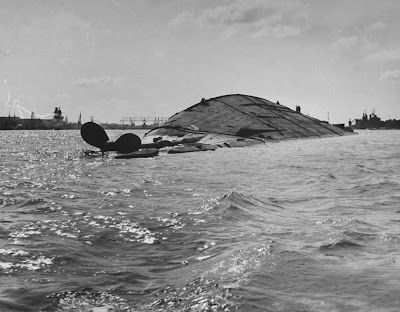 The U.S.S. Oklahoma was moored in Pearl Harbor’s Battleship Row on December 7, 1941, when the Japanese attacked. Outboard alongside U.S.S. Maryland, she took three torpedo hits almost immediately after the first Japanese bombs fell. As she began to capsize, two more torpedoes struck home, and her men were strafed as they abandoned ship. Within 12 minutes after the attack began, she had rolled over until halted by her masts touching bottom, her starboard side above water, and a part of her keel clear.
The U.S.S. Oklahoma was moored in Pearl Harbor’s Battleship Row on December 7, 1941, when the Japanese attacked. Outboard alongside U.S.S. Maryland, she took three torpedo hits almost immediately after the first Japanese bombs fell. As she began to capsize, two more torpedoes struck home, and her men were strafed as they abandoned ship. Within 12 minutes after the attack began, she had rolled over until halted by her masts touching bottom, her starboard side above water, and a part of her keel clear.Many of her crew, however, remained in the fight, clambering aboard the Maryland to help serve her anti-aircraft batteries. 429 officers and enlisted men were killed or missing. One of those killed — Father Aloysius Schmitt — was the first American chaplain of any faith to die in World War II. Thirty-two others were wounded, and many were trapped within the capsized hull, to be saved by heroic rescue efforts.
Labels:
1941,
Japan,
Pacific War,
Pearl Harbor,
Ships,
U.S. Navy,
United States
Tuesday, December 9, 2008
The Destroyed U.S.S. Arizona
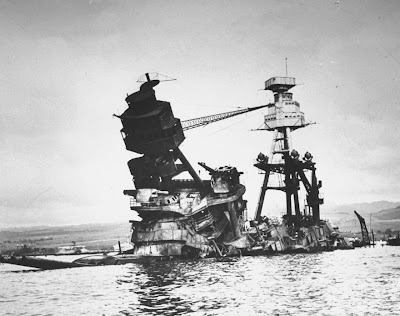 The exposed wreckage of the American battleship U.S.S. Arizona, most of which is now resting at the bottom of Pearl Harbor, is seen following the surprise Japanese attack on December 7, 1941. The Arizona (BB-39) was a Pennsylvania-class battleship of the United States Navy. She was commissioned in 1916 and saw action in World War I. The U.S.S. Arizona is best known for her cataclysmic and dramatic sinking, with the loss of 1,177 lives. The wreck was not salvaged, and continues to lie at the floor of the harbor. It is the site of a memorial to those who perished on that day.
The exposed wreckage of the American battleship U.S.S. Arizona, most of which is now resting at the bottom of Pearl Harbor, is seen following the surprise Japanese attack on December 7, 1941. The Arizona (BB-39) was a Pennsylvania-class battleship of the United States Navy. She was commissioned in 1916 and saw action in World War I. The U.S.S. Arizona is best known for her cataclysmic and dramatic sinking, with the loss of 1,177 lives. The wreck was not salvaged, and continues to lie at the floor of the harbor. It is the site of a memorial to those who perished on that day.
Labels:
1941,
Japan,
Pacific War,
Pearl Harbor,
U.S. Navy,
United States
Sunday, December 7, 2008
Pearl Harbor — December 7, 1941
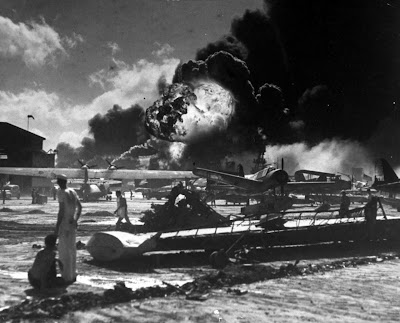 On this 67th anniversary of the Pearl Harbor attack, we will commemorate the occasion by featuring a series of images from that fateful event for the next several days. The unprovoked attack thrust the United States into the Second World War against the Japanese Empire — and two days later, Germany declared war against America as well. After over two years of aiding the Allies through material shipments, we were now involved in the battle for freedom across the world. The Isolationists were no more... we were all in it together to fight and win.
On this 67th anniversary of the Pearl Harbor attack, we will commemorate the occasion by featuring a series of images from that fateful event for the next several days. The unprovoked attack thrust the United States into the Second World War against the Japanese Empire — and two days later, Germany declared war against America as well. After over two years of aiding the Allies through material shipments, we were now involved in the battle for freedom across the world. The Isolationists were no more... we were all in it together to fight and win.
Labels:
1941,
Aircraft,
Japan,
Pacific War,
Pearl Harbor,
Ships,
U.S. Navy,
United States
Thursday, December 4, 2008
Detroit Makes Some Serious Models
 At the Detroit, Michigan Chrysler plant in February 1942, workers are assembling Sherman tanks — doing their part in aiding the war effort on the “home front” for the inevitable invasion of Nazi-occupied Europe that would eventually come.
At the Detroit, Michigan Chrysler plant in February 1942, workers are assembling Sherman tanks — doing their part in aiding the war effort on the “home front” for the inevitable invasion of Nazi-occupied Europe that would eventually come.
Labels:
1942,
European War,
Homefront,
Miscellaneous,
U.S. Army,
United States
Wednesday, December 3, 2008
Dutch Citizens Under Observation
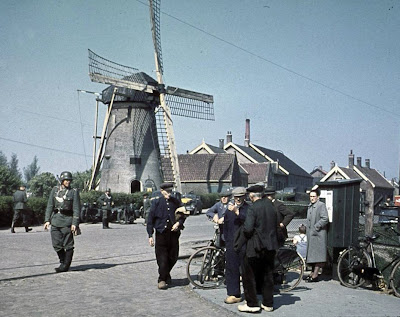 Following the capitulation of Holland during the Nazi blitzkrieg (“Lightning War”) across the Low Countries of Europe, German troops stationed along a street near a windmill keep a watchful eye as local citizens chat nearby. These citizens would be under Nazi rule until their liberation in 1944.
Following the capitulation of Holland during the Nazi blitzkrieg (“Lightning War”) across the Low Countries of Europe, German troops stationed along a street near a windmill keep a watchful eye as local citizens chat nearby. These citizens would be under Nazi rule until their liberation in 1944.
Labels:
1944,
European War,
Germany,
Holland,
The Third Reich
Tuesday, December 2, 2008
Bougainville: 1943
 United States Marines are seen during a respite in the action of the Bougainville campaign to take the Solomon Islands, 1943.
United States Marines are seen during a respite in the action of the Bougainville campaign to take the Solomon Islands, 1943.
Labels:
1943,
Pacific War,
Solomon Islands,
U.S. Marines
Monday, December 1, 2008
British Children Evacuated
 As war was declared in 1939, the British government knew that cities would be bombed, and thought that gas would be used. A million coffins were prepared. It was feared that many child casualties would affect morale, so pressure was put on parents to send the children away to the safety of the countryside.
As war was declared in 1939, the British government knew that cities would be bombed, and thought that gas would be used. A million coffins were prepared. It was feared that many child casualties would affect morale, so pressure was put on parents to send the children away to the safety of the countryside.Families gathered at railway stations. A label was tied to the children, giving their destination. The evacuations began on September 1, 1939. Some parents refused to allow their children to leave, but amazing numbers sent them away. Over one million evacuees left London by train.
School children travelled with their teachers, and children under five went with their mothers. Pregnant women were also evacuated. For many children the journey was exciting — they had never seen the country before. It was the first time they had seen farm animals. For many others, it was the first time they had been away from home and they were very distressed. Many evacuees felt homesick. Strangers chose them and took them to live in their homes. They went to the local school and had to make new friends. Some never settled down in their new homes. Others were happier with their new families than they had been at home. Very young children sometimes forgot their real parents.
Country people found the city children hard to cope with. They were horrified by their ignorance — for instance, many were amazed to find out that milk came from a cow. Many evacuees were poor — they had never worn underclothes, eaten food from a table or slept in a bed.
There was no bombing between September and Christmas so many parents took their children home again. Some children were evacuated again the next year and some stayed in the country for the whole of the war.
Labels:
1939,
Britain,
European War,
Germany,
London
Sunday, November 30, 2008
Ardennes Foxhole
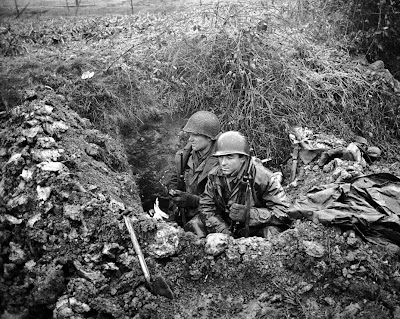 Two U.S. Army soldiers are seen holding their position in a foxhole near the front lines during the Battle of the Bulge in the Ardennes Forest in Belgium, December 1944.
Two U.S. Army soldiers are seen holding their position in a foxhole near the front lines during the Battle of the Bulge in the Ardennes Forest in Belgium, December 1944.
Labels:
1944,
Battle of the Bulge,
Belgium,
European War,
U.S. Army
Friday, November 28, 2008
 An American Sherman M4 tank moves past another gun carriage which slid off an icy road in the Ardennes Forest in Belgium on December 20, 1944, during the push to halt advancing German troops in what was to become known as the Battle of the Bulge — the last major German offensive of WWII.
An American Sherman M4 tank moves past another gun carriage which slid off an icy road in the Ardennes Forest in Belgium on December 20, 1944, during the push to halt advancing German troops in what was to become known as the Battle of the Bulge — the last major German offensive of WWII.
Labels:
1944,
Battle of the Bulge,
Belgium,
European War,
Germany,
The Third Reich,
U.S. Army
Thursday, November 27, 2008
Thanksgiving 1943
 Thanksgiving in 1943 fell on Thursday, November 25th, two days after the island of Tarawa was “secured.” The Tarawa invasion, was also the second time in the war that the United States faced serious Japanese opposition to an amphibious landing. Previous landings met little or no initial resistance. The 4,500 Japanese defenders were well-supplied and well-prepared, and they fought almost to the last man, exacting a heavy toll on the American Marines.
Thanksgiving in 1943 fell on Thursday, November 25th, two days after the island of Tarawa was “secured.” The Tarawa invasion, was also the second time in the war that the United States faced serious Japanese opposition to an amphibious landing. Previous landings met little or no initial resistance. The 4,500 Japanese defenders were well-supplied and well-prepared, and they fought almost to the last man, exacting a heavy toll on the American Marines.In order to set up forward air bases capable of supporting operations across the mid-Pacific, to the Philippines, and into Japan, the U.S. needed to take the Marianas Islands. The Marianas were heavily defended, and in order for attacks against them to succeed, land-based bombers would have to be used to weaken the defenses. The nearest islands capable of supporting such an effort were the Marshall Islands, northeast of Guadalcanal. Taking the Marshalls would provide the base needed to launch an offensive on the Marianas but the Marshalls were cut off from direct communications with Hawaii by a garrison on the small island of Betio, on the western side of Tarawa Atoll in the Gilbert Islands. Thus, to eventually launch an invasion of the Marianas, the battles had to start far to the east, at Tarawa.
The Japanese forces were well aware of the Gilberts' strategic location and had invested considerable time and effort fortifying the island. The American invasion force was the largest yet assembled for a single operation, consisting of 18 aircraft carriers, 12 battleships, 8 heavy and 4 light cruisers, 66 destroyers, and 36 transports. The force carried the 2nd Marine Division and a part of the Army's 27th Infantry Division, for a total of about 35,000 soldiers and Marines.
Only one Japanese officer, 16 enlisted men and 129 Koreans were alive at the end of the battle. Total Japanese and Korean casualties were about 4,713 dead. For the U.S. Marine Corps, 990 were killed and a further 2,296 wounded. A total of 687 U. S. Navy personnel also lost their lives in the landing attempts, giving a total of 1,677 American dead. Although the United States forces were seven times larger than the defending garrison, the Japanese were able to inflict substantial damage upon the U.S. force.
These heavy casualties sparked off a storm of protest in the United States, where the high losses could not be understood for such a tiny and seemingly unimportant island in the middle of nowhere. Writing after the war, Marine General Holland M. Smith asked,"Was Tarawa worth it?" "My answer," he said, "is unqualified: No. From the very beginning the decision of the Joint Chiefs to seize Tarawa was a mistake and from their initial mistake grew the terrible drama of errors, errors of omission rather than commission, resulting in these needless casualties." Thought Smith, "[We] should have let Tarawa 'wither on the vine.' We could have kept it neutralized from our bases on Baker Island, to the east, and the Ellice and Phoenix Islands, a short distance to the southeast.”
Labels:
1943,
Gilbert Islands,
Japan,
Marianas Islands,
Marshall Islands,
Pacific War,
Tarawa,
U.S. Army,
U.S. Marines,
U.S. Navy
Wednesday, November 26, 2008
Springtime Walk in England
Tuesday, November 25, 2008
General George C. Marshall
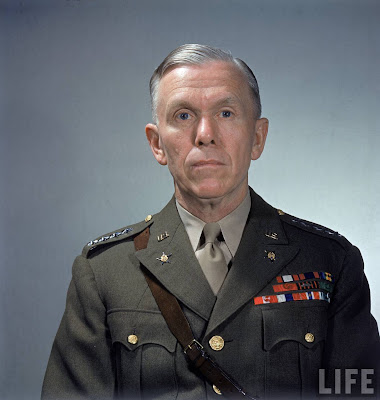 As Chief of Staff of the Army, George C. Marshall ordered the largest military expansion in U. S. history, inheriting an outmoded, poorly-equipped army of 189,000 men and, partly drawing from his experience teaching and developing techniques of modern warfare as an instructor at the Army War College, coordinated the large-scale expansion and modernization of the U. S. Army. Though he had never actually led troops in combat, Marshall was a skilled organizer with a talent for inspiring other officers.
As Chief of Staff of the Army, George C. Marshall ordered the largest military expansion in U. S. history, inheriting an outmoded, poorly-equipped army of 189,000 men and, partly drawing from his experience teaching and developing techniques of modern warfare as an instructor at the Army War College, coordinated the large-scale expansion and modernization of the U. S. Army. Though he had never actually led troops in combat, Marshall was a skilled organizer with a talent for inspiring other officers.During World War II, Marshall was instrumental in preparing the U.S. Army and Army Air Forces for the invasion of the European continent. Marshall wrote the document that would become the central strategy for all Allied operations in Europe. It was assumed that Marshall would become the Supreme Commander of Operation Overlord (The “D-Day” Normandy Invasion), but Roosevelt selected Dwight Eisenhower as Supreme Commander. The President told Marshall: "I didn't feel I could sleep at ease if you were out of Washington."
Labels:
1941,
European War,
U.S. Army,
U.S. Army Air Corps,
United States
Monday, November 24, 2008
Japanese Souvenir on Guadalcanal
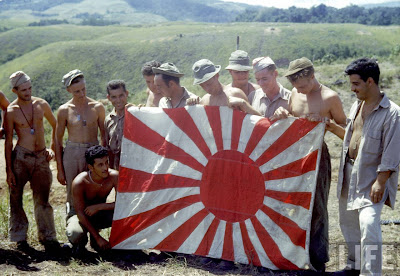 American soldiers hold a captured Japanese flag on Guadalcanal, in the Solomon Islands in 1943. The Guadalcanal Campaign, also known as the Battle of Guadalcanal, was fought between August 7, 1942, and February 9, 1943, in the Pacific theater. Fought on the ground, at sea, and in the air, this was a strategically significant, and decisive, campaign which pitted Allied forces against Imperial Japanese forces. The fighting took place on and around the island of Guadalcanal, and was the first major offensive launched by Allied forces against the Empire of Japan.
American soldiers hold a captured Japanese flag on Guadalcanal, in the Solomon Islands in 1943. The Guadalcanal Campaign, also known as the Battle of Guadalcanal, was fought between August 7, 1942, and February 9, 1943, in the Pacific theater. Fought on the ground, at sea, and in the air, this was a strategically significant, and decisive, campaign which pitted Allied forces against Imperial Japanese forces. The fighting took place on and around the island of Guadalcanal, and was the first major offensive launched by Allied forces against the Empire of Japan.
Labels:
1943,
Japan,
Pacific War,
Solomon Islands,
U.S. Army
Sunday, November 23, 2008
Saipan Marine
 A U.S. Marine on the island of Saipan in 1944. The Battle of Saipan was a battle of the Pacific campaign of World War II, fought on the island in the Marianas from 15 June 1944 to 9 July 1944. The invasion fleet embarking the expeditionary forces left Pearl Harbor on June 6th, 1944 — the very same day the allies launched Operation Overlord and the cross-channel invasion of Normandy. The Normandy landings were the larger amphibious landing, but the Mariana's invasion fielded the larger fleet. The American 2nd and 4th Marine Divisions and 27th Infantry Division, commanded by Lieutenant General Holland Smith defeated the 43rd Division of the Imperial Japanese Army commanded by Lieutenant General Yoshitsugu Saito.
A U.S. Marine on the island of Saipan in 1944. The Battle of Saipan was a battle of the Pacific campaign of World War II, fought on the island in the Marianas from 15 June 1944 to 9 July 1944. The invasion fleet embarking the expeditionary forces left Pearl Harbor on June 6th, 1944 — the very same day the allies launched Operation Overlord and the cross-channel invasion of Normandy. The Normandy landings were the larger amphibious landing, but the Mariana's invasion fielded the larger fleet. The American 2nd and 4th Marine Divisions and 27th Infantry Division, commanded by Lieutenant General Holland Smith defeated the 43rd Division of the Imperial Japanese Army commanded by Lieutenant General Yoshitsugu Saito.
Labels:
1944,
Japan,
Marianas Islands,
Pacific War,
Pearl Harbor,
Ships,
U.S. Marines
Saturday, November 22, 2008
Bugs Bunny Bond Rally
Some of the greatest politically-incorrect cartoons were made by the major animation studios during World War II. Cartoons were used for many functions during The War, from training soldiers about health and hygiene, to weapons training, to war bond sales and more. Today, we see our old pal Bugs Bunny doing his part to scrounge up some loot for Uncle Sam.
Thursday, November 20, 2008
Ready for Enemy Aircraft
 Shells are loaded into a Bofors anit-aircraft gun by Private First Class Paul Kaiser of Philadelphia, Pennsylvania, at a U.S. air base in England.
Shells are loaded into a Bofors anit-aircraft gun by Private First Class Paul Kaiser of Philadelphia, Pennsylvania, at a U.S. air base in England.
Labels:
1943,
Aircraft,
Britain,
European War,
U.S. Army,
U.S. Army Air Corps
Tuesday, November 18, 2008
Mission: Completed
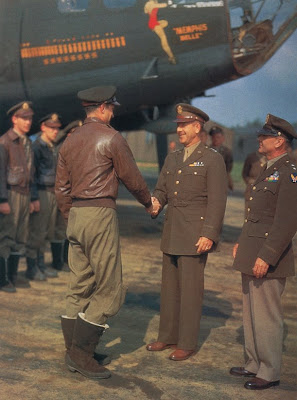 On June 6, 1943, General Jacob Devers congratulates Robert K. Morgan, Captain of the B-17 “Memphis Belle,” on completing twenty-five combat missions over occupied Europe. The “Belle” was chosen as the focal point of a war bond tour in the United States and was immortalized in William Wyler’s Oscar-winning documentary for the Office of War Information.
On June 6, 1943, General Jacob Devers congratulates Robert K. Morgan, Captain of the B-17 “Memphis Belle,” on completing twenty-five combat missions over occupied Europe. The “Belle” was chosen as the focal point of a war bond tour in the United States and was immortalized in William Wyler’s Oscar-winning documentary for the Office of War Information.
Labels:
1943,
Aircraft,
Britain,
European War,
U.S. Army Air Corps
Friday, November 14, 2008
P-47 Pilot Briefing

A briefing of P-47 pilots of the 56th Fighter Group at their base at Halesworth, England. Seated third from the left in the fourth row is fighter ace Bob Johnson. Johnson was the first USAAF fighter pilot in the European theater to surpass Eddie Rickenbacker's WWI score of 26 victories. He finished his combat tour with 27 kills, was later credited by the Eighth Air Force claims board with a 28th victory when a probable was reassessed as a destroyed, then reduced back to 27 when a post-war review discovered that Eighth Air Force had inadvertently switched credits for a kill he made with a double kill made by a fellow 56th Fighter Group pilot, Ralph A. Johnson, on November 26, 1943, a day when Robert Johnson aborted the mission after takeoff.

Labels:
1943,
Aircraft,
Britain,
European War,
U.S. Army Air Corps
Thursday, November 13, 2008
A Blessed “Flying Fortress”
 Roman Catholic padre Captain M.S. Ragan blesses a B-17 “Flying Fortress” crew before take-off. Before the war Captain Ragan, of Youngstown, Ohio, had been assistant pastor of St. Paul’s Church, Cleveland, Ohio.
Roman Catholic padre Captain M.S. Ragan blesses a B-17 “Flying Fortress” crew before take-off. Before the war Captain Ragan, of Youngstown, Ohio, had been assistant pastor of St. Paul’s Church, Cleveland, Ohio.
Labels:
1943,
Aircraft,
Britain,
European War,
U.S. Army Air Corps
Wednesday, November 12, 2008
Three Pilots Off Duty
 Captains Louis Sebille, Roland Scott, and Howard Posson were among the first pilots to fly B-26 Marauders with the 322nd Bomber Group. They were photographed near their base at Great Saling, England, in September 1943.
Captains Louis Sebille, Roland Scott, and Howard Posson were among the first pilots to fly B-26 Marauders with the 322nd Bomber Group. They were photographed near their base at Great Saling, England, in September 1943.
Labels:
1943,
Aircraft,
Britain,
European War,
U.S. Army Air Corps
Tuesday, November 11, 2008
Fish and Chips in the English Countryside

The British saw U.S. servicemen as a mixed blessing. It was widely accepted that their presence and military prowess were vital to the outcome of the war, but local male pride found the impact of their glamor, money, and demeanor on British women hard to stomach. There was respect and resentment in equal measure.
Here we see an airman in the United States Army Air Force savoring one of the joys of English life: fish and chips served in and eaten out of a newspaper in 1943.
Labels:
1943,
Britain,
European War,
U.S. Army Air Corps
Monday, November 10, 2008
Getting Well on the U.S.S. Yorktown
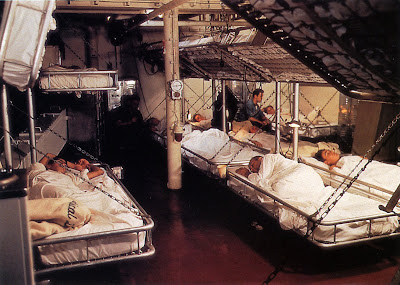 An image showing part of the U.S.S. Yorktown’s sick bay is the subject for today, photographed around November 1943.
An image showing part of the U.S.S. Yorktown’s sick bay is the subject for today, photographed around November 1943.
Labels:
1943,
Aircraft,
Pacific War,
Ships,
U.S. Navy
Sunday, November 9, 2008
Saturday, November 8, 2008
Thursday, November 6, 2008
Wednesday, November 5, 2008
Hitler’s “Mein Kampf” Documentary — Part I
The “Mein Kampf” documentary — a compilation of old news footage and photographs, selected by a Swedish film maker and presented with narration aimed to cite the monstrousness of Hitler and the Nazi regime — was the first comprehensive documentary of the Hitler era to be shown widely in post-war West Germany — and not until 1960.
Tuesday, November 4, 2008
News Parade: Bombing of Pearl Harbor (1942)
After a day off, we are back with a 1942 news film on the attack on Pearl Harbor.
Labels:
1941,
1942,
Japan,
Pacific War,
Pearl Harbor,
U.S. Navy,
United States
Saturday, November 1, 2008
Naval Photo Reconnaissance
Thursday, October 30, 2008
Navy Pilots Relax in Alaska
 U.S. Navy pilots relax between missions with a game of cribbage in their quarters at an advance base in the Aleutian Islands in the Northern Pacific in mid-1943.
U.S. Navy pilots relax between missions with a game of cribbage in their quarters at an advance base in the Aleutian Islands in the Northern Pacific in mid-1943.
Labels:
1943,
Aircraft,
Aleutian Islands,
Pacific War,
U.S. Navy
Wednesday, October 29, 2008
Beached U.S. Marines
 November 22, 1943: A view along the beach on Tarawa, in the Gilbert Islands, following a landing by the U.S. Marine Corps.
November 22, 1943: A view along the beach on Tarawa, in the Gilbert Islands, following a landing by the U.S. Marine Corps.
Labels:
1943,
Gilbert Islands,
Pacific War,
Tarawa,
U.S. Marines
Tuesday, October 28, 2008
Marine Artillery on Bougainville
 A U.S. Marines howitzer artillery emplacement on Bougainville in mid-December 1943 fires on Japanese positions on the Pacific island.
A U.S. Marines howitzer artillery emplacement on Bougainville in mid-December 1943 fires on Japanese positions on the Pacific island.
Labels:
1943,
Japan,
Pacific War,
Solomon Islands,
U.S. Marines
Monday, October 27, 2008
Aircraft on the Yorktown
 Naval aircraft warm up on the deck of the aircraft carrier U.S.S. Yorktown, during the campaign to recapture the Marshall Islands and Gilbert Islands. This photo was taken in November or December 1943 by a photographer of a U.S. Navy Photographic Unit.
Naval aircraft warm up on the deck of the aircraft carrier U.S.S. Yorktown, during the campaign to recapture the Marshall Islands and Gilbert Islands. This photo was taken in November or December 1943 by a photographer of a U.S. Navy Photographic Unit.
Labels:
1943,
Aircraft,
Gilbert Islands,
Marshall Islands,
Pacific War,
U.S. Navy,
United States
Sunday, October 26, 2008
Saturday, October 25, 2008
Basic Training The Hard Way
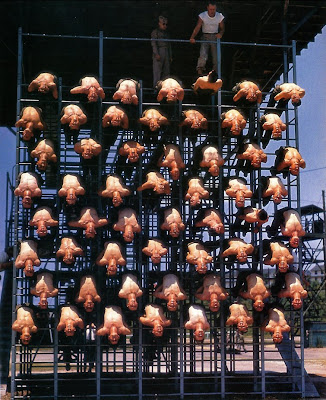 New U.S. Army recruits practice difficult sit-ups while perched on a training scaffold in 1942. The location may possibly be at Fort Knox, Kentucky, but cannot be determined exactly from the information given with the original photo. The U.S. Army soldier was going to be physically fit when he met either the German or Japanese soldier on a foreign battlefield.
New U.S. Army recruits practice difficult sit-ups while perched on a training scaffold in 1942. The location may possibly be at Fort Knox, Kentucky, but cannot be determined exactly from the information given with the original photo. The U.S. Army soldier was going to be physically fit when he met either the German or Japanese soldier on a foreign battlefield.
Friday, October 24, 2008
High-Level Lunch Meeting
 A meeting of the American Combined Chiefs of Staff continues over lunch, circa 1943. Left to right: Admiral William D. Leahy, U.S. Navy; General Henry “Hap” Arnold, U.S. Army; Admiral Ernest J. King, U.S. Navy; and General George C. Marshall, U.S. Army.
A meeting of the American Combined Chiefs of Staff continues over lunch, circa 1943. Left to right: Admiral William D. Leahy, U.S. Navy; General Henry “Hap” Arnold, U.S. Army; Admiral Ernest J. King, U.S. Navy; and General George C. Marshall, U.S. Army.
Labels:
1943,
U.S. Army,
U.S. Army Air Corps,
United States
Thursday, October 23, 2008
General Eisenhower — 1943
 A formal portrait of General Dwight D. Eisenhower, taken in late 1943, at the time of his appointment as Supreme Commander of the Allied Forces in Western Europe.
A formal portrait of General Dwight D. Eisenhower, taken in late 1943, at the time of his appointment as Supreme Commander of the Allied Forces in Western Europe.
Labels:
1943,
Eisenhower,
European War,
U.S. Army,
United States
Wednesday, October 22, 2008
B-17G Flying Fortress Crew Heads Out
 The crew of a Boeing B-17G Flying Fortress is shown somewhere in England being shuttled out to their aircraft for a mission. Generally considered the defining B-17 design, all changes made in the B-17F production run were incorporated into the final B-17G version. It also included a Bendix chin-turret, an innovation derived from the unsuccessful YB-40 escort version, bringing defensive armament to thirteen .50-calibre machine guns. Some 8,680 were built.
The crew of a Boeing B-17G Flying Fortress is shown somewhere in England being shuttled out to their aircraft for a mission. Generally considered the defining B-17 design, all changes made in the B-17F production run were incorporated into the final B-17G version. It also included a Bendix chin-turret, an innovation derived from the unsuccessful YB-40 escort version, bringing defensive armament to thirteen .50-calibre machine guns. Some 8,680 were built.
Labels:
1943,
Aircraft,
Britain,
U.S. Army Air Corps
Tuesday, October 21, 2008
America Gets Closer to War
 In the Fall of 1941, with Europe already at war, United States Army draftees are drilled at Fort Lewis, Washington. Fort Lewis, named after Meriwether Lewis of the Lewis and Clark expedition, is one of the largest and most modern military reservations in the United States.
In the Fall of 1941, with Europe already at war, United States Army draftees are drilled at Fort Lewis, Washington. Fort Lewis, named after Meriwether Lewis of the Lewis and Clark expedition, is one of the largest and most modern military reservations in the United States. As World War II loomed in the future, Fort Lewis became more active. Between May 1939 and March 1941, the post population grew from 5,000 to 37,000 troops. To house the new soldiers, a 2000-acre North Fort Lewis complex was completed by August 1941. The bombing of Pearl Harbor sent a tremor of fear through the West Coast. Troops from Fort Lewis helped secure McChord Field, Camp Murray, and Fort Lewis itself. As time went on, the nervousness eased, and the post got down to wartime business. Before the end of World War II the post had trained the 3rd, 33rd, 40th, 41st, 44th and 96th Infantry Divisions, plus many brigades and smaller size units. A camp for prisoners of war was established in July 1943 and was continued for 3 years.
Monday, October 20, 2008
Patriotic Children
 Children stage a patriotic demonstration in Southhampton, Connecticut. The events that had propelled the U.S.A. into the war stirred not only the nation’s leaders — but also its population — out of their isolationism. The United States was to regard itself as the bastion of freedom for many decades to come.
Children stage a patriotic demonstration in Southhampton, Connecticut. The events that had propelled the U.S.A. into the war stirred not only the nation’s leaders — but also its population — out of their isolationism. The United States was to regard itself as the bastion of freedom for many decades to come.
Subscribe to:
Posts (Atom)





